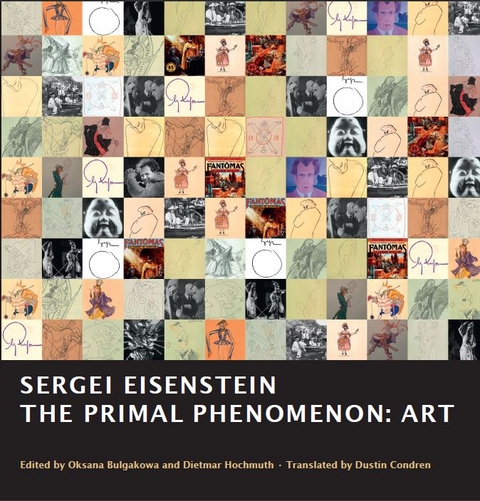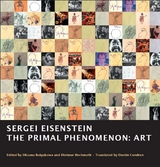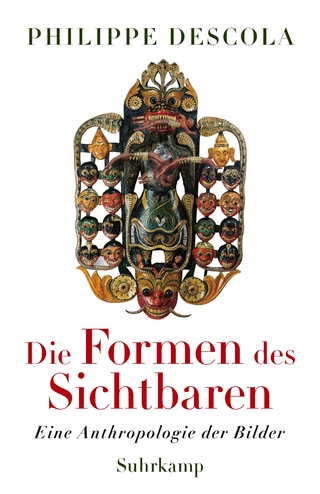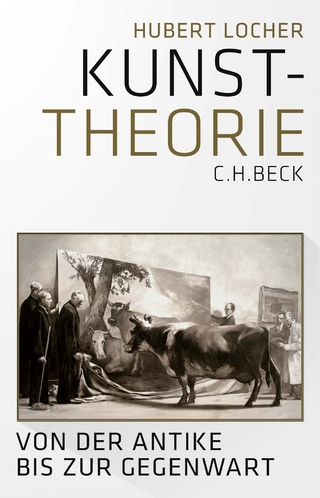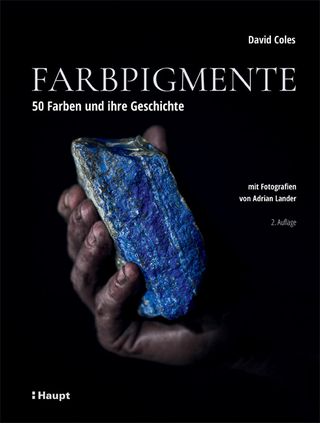Sergei Eisenstein. THE PRIMAL PHENOMENON: ART
PotemkinPress (Verlag)
978-3-943190-12-0 (ISBN)
What do the movement of a chicken and the development of a plot in a melodrama, in Manet’s and Zola’s style have in common – or the way a spider sees the world, Goethe's interpretation of the gestures in Leonardo's supper and Balzac’s fondness for secret societies, the bisexuality of the gods and the misogyny of master detectives, the film montage, the family of the worms and the Osiris myth, and how the metonymic situation in Shakespeare differs from the metaphorical one at Chesterton?
In his search for the primal phenomenon art, Sergei Eisenstein moves from the circus to Bach and Shostakovich, from there to Fântomas, Sherlock Holmes and Ellery Queen, sees in Mark Twain a double of Dostoevsky and his own double in Ben Jonson, investigates rhythm, actor’s movements, composition in painting, the language of the objects in Swift and the concrete thinking of Tolstoy, and writes about his fiasco in Hollywood.
Eisenstein analyzes almost all the arts – music, the theater of the Elizabethans and Meyerhold, the paintings of Leonardo, Manet and Max Ernst, French and Japanese erotic caricatures, the novels of Balzac, Zola, Dostoyevsky. Dreiser, D. H. Lawrence, Conan Doyle, Stein-beck, Ellery Queen, and his own films. He quotes psychologists, anthropologists, psycho-analysts, linguists, folklorists, art historians and zoologists. In order to discover the primor-dial phenomenon of art and to understand the secret of the film form. (Oksana Bulgakowa)
___________________________
Was hat die Bewegung eines Huhns mit der Entwicklung der Handlung im Melodrama, die Manier Manets und Zolas mit dem Sehen der Spinne, Goethes Auslegung der Gestensprache von Teilnehmern an Leonardos Abendmahl mit Balzacs Neigung zu Geheimgesellschaften, die Bisexualität der Götter mit der Mysogenie von Meisterdetektiven, die Filmmontage mit der Familie der Plattwürmer und dem Osiris-Mythos gemein, und wodurch unterscheidet sich die metonymische Situation bei Shakespeare von der metaphorischen bei Chesterton?
Auf der Suche nach dem Urphänomen der Kunst und einer Erklärung für deren unwiderstehliche Wirkung bewegt sich Sergej Eisenstein vom Zirkus zu Bach und Schostakowitsch, von dort aus zu Fântomas, Sherlock Holmes und Ellery Queen, sieht in Mark Twain einen Doppelgänger von Dostojewski und untersucht Rhythmus, Bewegung, Komposition in der Malerei, die Sprache der Gegenstände bei Swift und das konkrete Denken bei Tolstoi, sein Fiasko in Hollywood und Ben Jonson, als dessen Doppelgänger er sich selbst sieht.
Eisenstein analysiert nahezu alle Künste – Zirkus, Musik, das Theater der Elisabethaner und Meyerholds, die Malerei von Leonardo, Manet und Max Ernst, erotische Karikaturen der Franzosen und Japaner, die Romane von Swift, Balzac, Zola, Dostojewski. Dreiser, D. H. Lawrence, Conan Doyle, Steinbeck und Ellery Queen, seine eigenen Filme und zitiert Psychologen, Anthropologen, Psychoanalytiker, Linguisten, Mythenforscher, Folkloreforscher, Kunsthistoriker, Romanisten und Zoologen, einzig und allein um das Urphänomen der Kunst, das Geheimnis der Form und des Films zu enträtseln. (Oksana Bulgakowa)
German description below Sergei Eisenstein (1898 – 1948), the great Soviet film director, was born in Riga. His father was a Jew of German origin who had converted to Russian Orthodoxy and who passed himself off as a Baltic baron. His mother was the daughter of wealthy Russian (and traditionally anti-Semitic) merchants from St Petersburg. Eisenstein’s life was full of unforeseen diversions and turns of events: Would he become an architect like his father and go into German exile in 1918? Would he be banished as a Freemason in 1925, or stay in the USA in 1932? Would he be sentenced by a special court in 1939 to be executed, like his friends Isaak Babel and Vsevolod Meyerhold? Or would he ultimately die as a Stalin Prize winner (for Ivan the Terrible, Part I) of a heart attack caused by the ban on Part II? ___________________________ Eisenstein wurde 1898 in Riga (heute Lettland) geboren. Sein Vater war ein aus Deutschland stammender und zur Orthodoxie konvertierter Jude, der sich als Ostseebaron ausgab – seine Mutter eine Tochter reicher russischer (und traditionell antisemitischer) Kaufleute aus St. Petersburg. Das Leben Sergej Eisensteins war nicht eben arm an unvorhergesehenen Verführungen und Wendungen: Architekt werden wie der Vater und 1918 ins deutsche Exil gehen oder 1925 als Freimaurer in die Verbannung, 1932 in den USA bleiben oder – wie seine Freunde Isaak Babel und Wsewolod Meyerhold – 1939 durch ein Sondergericht zur Erschießung verurteilt werden oder aber als gefeierter Stalinpreisträger (für “Iwan der Schreckliche”, Teil I) letztlich an einem Herzinfarkt sterben – für das Verbot von Teil II.
German description below Oksana Bulgakowa (editor, author of the afterword and detailed comments), born in 1954 in Nikolaev, then USSR (today Ukraine). Studied film history and film studies at the Central Moscow Film School VGIK from 1972-77. Relocation (following the marriage of Dietmar Hochmuth) to Berlin: Doctorate (1982) at the Humboldt University. She has worked as an author and editor of more than 25 books about film history, as well as a curator (of exhibitions and festivals) and a film author, lecturer, visiting professor and professor of film history and studies in Berlin, Leipzig, Stanford, Berkeley, Cologne,Vienna et al. Currently she is a professor of film studies at the Johannes Gutenberg University in Mayence (Mainz, Germany) where she leads the film study and film history department since 2008. --- Oksana Bulgakowa (Herausgabe, Übersetzung und ausführliches Nachwort), geboren 1954 in Nikolajew, damals UdSSR (heute Ukraine). Studium der Filmwissenschaft an der Moskauer Filmhochschule WGIK von 1972-77. Umzug (infolge Heirat von Dietmar Hochmuth) nach Berlin. Aspirantur und Promotion (1982) an der Humboldt-Universität. Tätigkeit als Autorin und Herausgeberin von mehr als 25 Büchern zur Filmgeschichte sowie als Kuratorin (von Ausstellungen und Festivals) und Filmautorin, als Dozentin, Gastprofessorin und Professorin für Filmtheorie und -geschichte u.a. in Berlin, Leipzig, Stanford, Berkeley, Köln. Seit 2008 Lehrstuhlinhaberin für Filmwissenschaft und -geschichte an der Universität zu Mainz.
German description below Dietmar Hochmuth (editor), born in Berlin in 1954 (then GDR). After his diploma at the Central Moscow Film School VGIK [in Georgi Danelia's masterclass] he worked as a director and author (made three and a half feature films and about 25 documentaries, mainly for TV - arte, ZDF, 3sat, NDR, SR, ORB). In addition to filmmaking, he also worked as a lecturer, visiting professor and professor of film making in Berlin, Stanford, Cologne, Mainz etc., as well as an author, translator and editor. In 1996 he founded the publishing house for books on film and new media - PotemkinPress, with special interest in still largely unpublished texts by Sergei Eisenstein. [www.PotemkinPress.com] _______________________ Dietmar Hochmuth (Herausgabe und Übersetzung), geboren 1954 in Berlin (damals DDR). Nach einem Regiestudium an der Moskauer Filmhochschule WGIK [bei Georgi Danelia] Arbeit als Regieassistent, später Regisseur und Autor (dreieinhalb Kinospielfilme und ca. 25 Dokumentarfilme, hauptsächlich fürs Fernsehen - arte, ZDF, 3sat, NDR, SR, ORB). In Ergänzung zum Filmemachen Tätigkeit als Dozent, Gastprofessor und Professor für Filmemachen in Berlin, Stanford, Köln, Mainz etc. sowie als Autor, Übersetzer und Herausgeber. 1996 Gründung des Verlages für Filmliteratur und Neue Medien PotemkinPress, dessen besonderes Interesse dem noch zum größten Teil unveröffentlichten theoretischen Érbe Sergej Eisensteins gilt. [www.PotemkinPress.com]
| Erscheinungsdatum | 12.09.2017 |
|---|---|
| Übersetzer | Dustin Condren |
| Verlagsort | Berflin |
| Sprache | englisch |
| Maße | 210 x 210 mm |
| Gewicht | 774 g |
| Einbandart | gebunden |
| Themenwelt | Kunst / Musik / Theater ► Allgemeines / Lexika |
| Geisteswissenschaften | |
| Schlagworte | Andrei Bely • Andrej Bely • Androgyn • Ausdrucksbewegung • Bach • Balzac • Battleship Potemkin • Ben Jonson • Bisexualität • Bisexuality • Brüder Karamasow • Chesterton • Der Kaufmann von Venedig • D. H. Lawrence • Dostojewski • Dramaturgie • Dramaturgy • Dramenaufbau • dreiser • Editing • Eisenstein • Ellery Queen • Ernst Kretschmer • E. T. A. Hoffmann • E.T.A. Hoffmann • Fabel • Fântomas • Filmmontage • Freud • Gestaltpsychlogie • Goethe • Gogol • Jacques Deval • Kriminalpsychologie • Kriminalrom • Leonardo • Magnus Hirschfeld • Manet • Metapher • Metonymie • Metonymy • Meyerhold • Myth • Mythos • Naum Kleeman • Naum Kleiman • Oksana Bulgakowa • Osiris-Mythos • Panzerkreuzer Potemkin • Plattwürmer • Plot • Puschkin • Pushkin • Rätsel • René Fülöp-Miller • Rhythm • Rhythmus • Sandor Ferenczi • Schklowski • Schostakowitsch • Shakespeare • Steinbeck • Sujet • SWIFT • Tolstoi • Twain • Van Dine • Wilhelm Wundt • Zirkus • Zola |
| ISBN-10 | 3-943190-12-9 / 3943190129 |
| ISBN-13 | 978-3-943190-12-0 / 9783943190120 |
| Zustand | Neuware |
| Haben Sie eine Frage zum Produkt? |
aus dem Bereich
